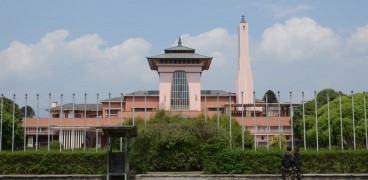The Halesi-Maratika Caves, better known as the Haleshi Mahadev mandir, is situated next to Mahadevasthan town, in eastern Nepal's Khotang district. The cave and temple are roughly 185 km southwest of Mt Everest (8,848 m) and are 3100 ft. – 4734 ft. above sea level.
This temple is an essential place of pilgrimage for Buddhists and Hindus. Hindus named the caves the Halesi Mahadev Temple by associating them with Mahadeva, a form of Shiva. It is also regarded as East's Pashupatinath.
Halesi Mahadevstan
Halesi-Martika Cave sits in Nepal's Khotang district. Halesi Mahadev holds significance for many religious sites in the Khotang district.
It is situated about 222 kilometres from Kathmandu and passes Dhulikhel, Nepalthok, Khurkot, Ghurmi, Okhaldhunga, and Jayaram along the way. It takes around 8-9 hours to reach Halesi Mahadev as we pass via the narrow route.
It is situated between the sacred rivers Dudh Koshi to the right and Sunkoshi to the east, in the hilly area of the region.

Halesi Cave: Mystical Depths Unveiled
Credit:ktmguide.com
The temple is situated in a stunning cave, at the peak of a small hill. There are also many other tiny caves lying there too. It's dark inside the cave and bats can be seen flying around the cave.
Halesi-Maratika caves are located 67 feet below the earth's surface. The entrance is formed like a half-moon and faces east. It has a circular form, 193 feet in diameter, with another, a similar cave located below. The floor of the caves has a circumference of 223 feet.
This is the only cave that is situated in the 4th remote hilly area and is thought to have existed for 6,000 years. This is a region overflowing with natural wonders and cultural heritage.
There are three enigmatic caves which are considered to be Lord Shiva's three heads. When we enter the first cave, we see an image of Lord Shiva that is named Mahadev Haleshwar. A picture of Nandi (Shiva's animal ride)is found in the second cave.
Halesi Mahadev is Shiva Linga, two-foot-tall, which is blessed inside the chamber. Behind each other on the north of the Shiva Linga are two pillars allowing a narrow move.
Rumours have it that sinners cant enter the cave through the small passage.
How can we reach Halesi Mahadevstan mandir?
There is an air service from Kathmandu to Lamidanda. Still, there is no regular flight service, and the planes only fly for three days a week to Lamidanda. After Lamidanda there is a trekking path to the temple of Halesi Mahadev, which takes about 5-6 hours by vehicle.

Halesi Cave: Spiritual Enigma Explored
Credit:ktmguide.com
There is a Helipad near the Halesi Mahadev temple, and it takes 2 hours from Kathmandu to Halesi to Kathmandu to reach the Halesi Mahadev temple by private helicopter.
There is a frequent bus service from Kathmandu to Katari, Udaypur. There is an unpaved route from Katari to Ghurmi where we can go by jeep or local hired car. There is no path after Ghurmi to Halesi.
Origin of Halesi Mahadevstan
In Himalayan literature, the caves of Halesi-Maratika was alluded to as far back as the 12th century.
Kathang Zanglingma, a biography of Padmasambhava, a terma discovered and passed on by Nyangrel Nyima Ozer, explains the initial occurrences that gave Vajrayana practitioners a holy position in the Maratika Caves.
According to Hindu scriptures, Lord Shiva is thought to have hidden in these caves when he was chased away by the demon King Bhasmasur about 6,000 years ago.
Religious importance of Halesi Mahadevstan
The Halesi-Martika caves are believed to have served as a home to Lord Shiva when he was hiding from the demon Bhasmasur.
Halesi Mahadevstan is an essential site of pilgrimage for both Hindus and Buddhists situated in eastern Nepal.
The cave is best known in the east as 'the East's Pashupatinath.' Thousands of pilgrim goers visit these caves during the time of Mahashivaratri and Bala Chaturdashi.
Hinduism
Hindus from India have come here to worship Lord Shiva after having scaled several hills. A lot of people come here during Shrawan's month from locations like Ladania and Jayanagar to pray to Haleshi Mahadev.
Fairs and festivals are conducted in the caves during the celebrations of Bhasmasur, Rama Navami, and Ganesh Chaturthi holidays.
Buddhism
Mandarava and Padmasambhava discovered a variety of terma encoded by Dakini Sangwa Yeshe elementally in the cave. These termas are listed among Buddha Amitabha's longevity teachings and were issued at Bodhisattva Avalokiteswara's behest.

Halesi Harmony: Faiths Unite
Credit:nepaltravellers.com
It is here, at the Halesi-Martika caves, that Mandarava and Padmasambhava attained immortality (or eternal life) Vidyadhara.
Halesi Mahadevstan during Festivals
Lord Vishnu was the first-ever devotee to pay respect to the Haleshi Mahadeva in the Satya Yuga. Afterwards, this holy position has been paying tribute to many rulers, sages, devotees, scholars, writers, hermits, abbots, ascetics, and Shankaracharya.
There's a tradition of conducting unique rituals at the Haleshi Mahadev mandir at specific festivals like Bala Chaturdashi, Shiva Ratri, Ram Nawami, and Teej etc.

Halesi: Sacred Caves, Spiritual Oasis
Credit:Nepaltravellers.com
In particular, devotees conduct numerous other worship activities such as reading the Rudri, the Chandi, and the Vedas followed by fire sacrifices, recitals, burning 10 million holy threads and giving millions of wood apple leaves etc.
The Haleshwor Mahadeva is considered as the deity of meeting the desires of the faithful devotees and granting them boons. So devotees swear solemnly and behave as their desires have been accomplished accordingly.
For more information on temples within Nepal, please visit hopnepal.com.
















